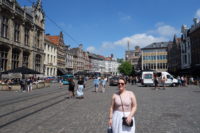 When we tour Europe, one of the great challenges is staying fed. By this, I don’t mean we don’t get food – we always eat lots on these trips. It’s more that we can’t seem to get the day to work out right so that we eat meals at normal times. Tours and sightseeing do not always line up in neat patterns like that. So today, for instance, we ate breakfast first thing. Normal. Then we did some things (descriptions coming) such that we could have eaten just before noon, only three hours after a fairly large breakfast, or, we could tour on and eat when we could (probably 2:00). We chose the latter. We then snacked around 5:00 because we could and wanted to, but then that threw off the need for supper, which we still ate at 7:00 so that we would not be hungry later on. Granted, it is not a terrible problem to have; it just seems to pop up on every European tour we do at some point.
When we tour Europe, one of the great challenges is staying fed. By this, I don’t mean we don’t get food – we always eat lots on these trips. It’s more that we can’t seem to get the day to work out right so that we eat meals at normal times. Tours and sightseeing do not always line up in neat patterns like that. So today, for instance, we ate breakfast first thing. Normal. Then we did some things (descriptions coming) such that we could have eaten just before noon, only three hours after a fairly large breakfast, or, we could tour on and eat when we could (probably 2:00). We chose the latter. We then snacked around 5:00 because we could and wanted to, but then that threw off the need for supper, which we still ate at 7:00 so that we would not be hungry later on. Granted, it is not a terrible problem to have; it just seems to pop up on every European tour we do at some point.
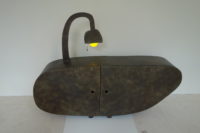 The touring started off with an interesting visit to Design Museum Gent. Belgians love design, even for ordinary objects, and that has been borne up in this university town. There are several museums, many art shops, bookstores on art and design, and stores selling high-end (and well-designed) household goods. The Design Museum itself was interesting, with the collection housed in an old wooden house surrounding a new steel-and-glass structure, so that you had the contrasts of the dark wooded house and the airy glass section.
The touring started off with an interesting visit to Design Museum Gent. Belgians love design, even for ordinary objects, and that has been borne up in this university town. There are several museums, many art shops, bookstores on art and design, and stores selling high-end (and well-designed) household goods. The Design Museum itself was interesting, with the collection housed in an old wooden house surrounding a new steel-and-glass structure, so that you had the contrasts of the dark wooded house and the airy glass section.
The main focus of the exhibit today was on a young designer named Baas. He caught the design world’s attention with his senior work in university, when he took wooden furniture, burned it, and the coated it with lacquer to make it strong enough to be used again. There were several pieces from the “Smoke” series on display, and I was not sure about them. Interesting idea, but I was not sure that I liked it as design or art. They were followed by several movies of Baas himself in a room doing various things (like tossing in bed while real sheep wandered about). They were clever and interesting and even thought-provoking, but they seemed to me to be all art and no design (going by my own rule of thumb that design has some practical aspect to it, whereas art does not need to be practical at all). Still wasn’t sure about Baas.
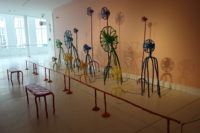 Then he pulled it out for me, getting both thoughtful and whimsical. We encountered several pieces of furniture cast out of bronze that had been based on quick and imaginative sketches Baas came up with. He was trying to create fantastical objects that seemed to defy gravity. I liked them.
Then he pulled it out for me, getting both thoughtful and whimsical. We encountered several pieces of furniture cast out of bronze that had been based on quick and imaginative sketches Baas came up with. He was trying to create fantastical objects that seemed to defy gravity. I liked them.
Baas has a lot of work that focuses on or brings in an element of time. He had several functional clocks on display where the clock faces were films of people drawing and then erasing the hands of the clock, and then drawing them again the next minute. He really filmed the people (including himself) doing this for twelve hours so that the clocks would really tell time. Two of the clocks even had videos of bells hanging above the heads of the hands-keepers, and when it got to the top of the hour, the person would reach up and hit the bell the requisite number of times. Baas even had a film from shot from above showing two people sweeping two lines of garbage and sand around in the form of hands on a clock, so that it really functioned as well.
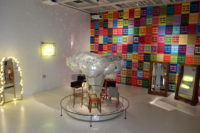 The next room was really fun. There were a bunch of working fans that looked as if they had been sculpted out of colorful clay. Then, Baas collaborated with an artist to make a claymation film of the fans being made as a fiftieth anniversary film. The work was displayed in 2006, so the film had a date of 2056. It was pretty funny.
The next room was really fun. There were a bunch of working fans that looked as if they had been sculpted out of colorful clay. Then, Baas collaborated with an artist to make a claymation film of the fans being made as a fiftieth anniversary film. The work was displayed in 2006, so the film had a date of 2056. It was pretty funny.
Then, Baas had an entire room filled with a glitzy, over-the-top display for five simple chairs. He had entered the display in a design show in Milan, and he thought the competition had become all about getting the most social media hits. So, he decided to poke fun at things by presenting his chairs as the center of a circus, with Baas himself playing a carnival barker. It was glitzy and loud and fun, and the gently mocking presentation won Baas best-in-show that year.
So, in the end, I liked Bass’ work. I think he would either be a really fun guy to hang out with (which is what I hope), or he would be really pretentious.
The museum had two other floors of various displays on design, and some were quite eye-catching, while a few were merely eye-rolling. The entire museum took about two hours, which is an excellent size for a museum. Oh – one quirky thing I loved. One room had an elaborate carved wooden chandelier. On the chandelier was a carved boat. Someone, and I really hope it was a curator, put a Playmobil pirate in the boat. That made me smile broadly.
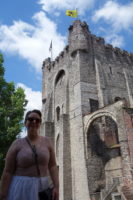 After seeing a pirate, it was only right that we storm a castle. Ghent’s castle is imposing, which was the idea. It was built in the late 1100s as a display of power to the independent townspeople of Ghent. It later became the home of the local counts and justice system, and eventually, by the late 1800s, had become a textile mill. It got restored in the late 1800s and early 1900s, and is now a great tourist attraction. Meredith really loved it since the tour was well laid out with arrows, and numbers marked each place you were supposed to go. That way, Mer could be sure she saw everything.
After seeing a pirate, it was only right that we storm a castle. Ghent’s castle is imposing, which was the idea. It was built in the late 1100s as a display of power to the independent townspeople of Ghent. It later became the home of the local counts and justice system, and eventually, by the late 1800s, had become a textile mill. It got restored in the late 1800s and early 1900s, and is now a great tourist attraction. Meredith really loved it since the tour was well laid out with arrows, and numbers marked each place you were supposed to go. That way, Mer could be sure she saw everything.
The castle keep and tower offered good views of Ghent, although Mer complained that the defensive shutters in the ramparts were obstructing views for the under-six-foot crowd. I pointed out that the designers were probably not thinking of tourism and views. Nothing too historical happened in the castle (in a world-history sense), and other castles are bigger or better situated for views, but it was fun to wander around inside the place.
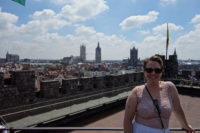 After a quick lunch at 2:00, we ended our touring for the day with the walk in Rick Steve’s guide book. Since we are thorough people when it comes to things like this, it took us about four hours to do the walk, which did include a chocolate break and a fries break (two things for which Belgium is known). We did the whole walk, but a few highlights stood out.
After a quick lunch at 2:00, we ended our touring for the day with the walk in Rick Steve’s guide book. Since we are thorough people when it comes to things like this, it took us about four hours to do the walk, which did include a chocolate break and a fries break (two things for which Belgium is known). We did the whole walk, but a few highlights stood out.
We went into the Church of St. Nicholas, which is under renovation in the front half (entrance) of the church. This church is also airy and very tall inside. The church organist was practicing while we were there, so that added to the atmosphere. There was also an exhibit of photographs around the whole church showcasing bald women, mostly women who had lost their hair to chemo.
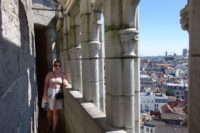 We next toured the town bell tower. We got to see the drum that ran the bells in action (it activates every quarter hour). Then, Mer, of course, went out on the narrow ledge at the top of the tower, which I passed on. Instead, I read about the history of the biggest bell in the tower, which has been cast three times – once to be replaced, and once because the second one broke (although after a hundred years, it was finally repaired years in 2006). We finished up with a video on the unexpectedly complex manufacturing process for casting large bells; it is dozens of steps over several weeks. I had no idea, and given the technology used now, this is not how it has always been done.
We next toured the town bell tower. We got to see the drum that ran the bells in action (it activates every quarter hour). Then, Mer, of course, went out on the narrow ledge at the top of the tower, which I passed on. Instead, I read about the history of the biggest bell in the tower, which has been cast three times – once to be replaced, and once because the second one broke (although after a hundred years, it was finally repaired years in 2006). We finished up with a video on the unexpectedly complex manufacturing process for casting large bells; it is dozens of steps over several weeks. I had no idea, and given the technology used now, this is not how it has always been done.
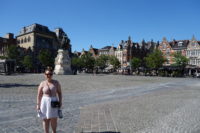 The rest of the walk was around town, including taking us to a square we had not been to before, and which happily sold fries that were recommended in our guide book. The tour finished back near the castle, so we headed back home to rest for a bit before setting out for supper and a fairly early evening back at the hotel, happily well fed.
The rest of the walk was around town, including taking us to a square we had not been to before, and which happily sold fries that were recommended in our guide book. The tour finished back near the castle, so we headed back home to rest for a bit before setting out for supper and a fairly early evening back at the hotel, happily well fed.